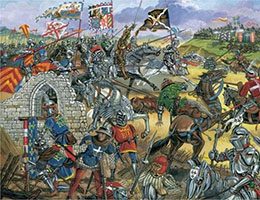 The expression stand hard , from the French language, refers to maintaining firmness. It came to Old French as standard , which led to standard in Spanish. The term is used to name an emblem .
The expression stand hard , from the French language, refers to maintaining firmness. It came to Old French as standard , which led to standard in Spanish. The term is used to name an emblem .
Artillery and cavalry often use banners: in these contexts, it is a square of cloth with the corps' national emblem , which is placed on a staff for easy display. Similar insignia are also used by different corporations, whether religious or civil.
If we focus on the meaning that defines the term banner as a type of flag used by certain heads of state, there are ancient references that take us back to the time of King Alfonso X of Castile , who lived in the mid-13th century. The context in which the monarch recorded the use of a banner is the regulatory body titled Las Siete Partidas , which sought to unify the legal issues of the kingdom .
The head of state is the highest authority of his land, who represents it as the only entity, both before himself and abroad. In other words, he is considered the symbol of his own country in front of his people and the world. Regarding their specific functions, they vary depending on the political system in force, so it is not possible to define a generalized list.
The flag that is raised in the place where the president or head of state is located is called the presidential banner . The United States presidential banner , for example, features the presidential coat of arms in the center of a rectangular cloth whose background is blue. The presidential banner of Argentina , meanwhile, is light blue and has the coat of arms of the Nation in its central sector, as well as five-pointed stars at the corners of the cloth.
At this point the concept opens up to give rise to two other possibilities: the royal standard and the imperial one. It is important to note that, basically, all three have practically the same meaning, since one or the other is simply used according to the characteristics of the government system of each country. In other words, we only talk about a presidential banner if the country in question is not a monarchy.
 The royal standard , on the other hand, is the badge that represents a king . In some cases, the royal standard does not vary beyond the monarch, while in others it is associated with each particular member of the royal family. The royal standard of Spain is a square crimson emblem with the monarch's coat of arms in the center. In Sweden , the royal standard is composed of the Swedish flag finished in three points and with the national coat of arms on a white background that is applied in the center of the cross of the flag.
The royal standard , on the other hand, is the badge that represents a king . In some cases, the royal standard does not vary beyond the monarch, while in others it is associated with each particular member of the royal family. The royal standard of Spain is a square crimson emblem with the monarch's coat of arms in the center. In Sweden , the royal standard is composed of the Swedish flag finished in three points and with the national coat of arms on a white background that is applied in the center of the cross of the flag.
When the monarch has the title of emperor , that is, he rules an empire or has other kings as vassals, the banner used to indicate that he is present somewhere is the imperial one . Although in another time its use was very common, today it is only that of Japan, since its monarch is the only one who holds the title of emperor.
In ancient battles , where numerous groups of soldiers engaged in bloody hand-to-hand fights, the banner was carried high on horseback to guide all the members of the side.
In colloquial language, finally, symbols are called banners: "Cristiano Ronaldo is the banner of the Portuguese team," "The actress became a banner of veganism."
